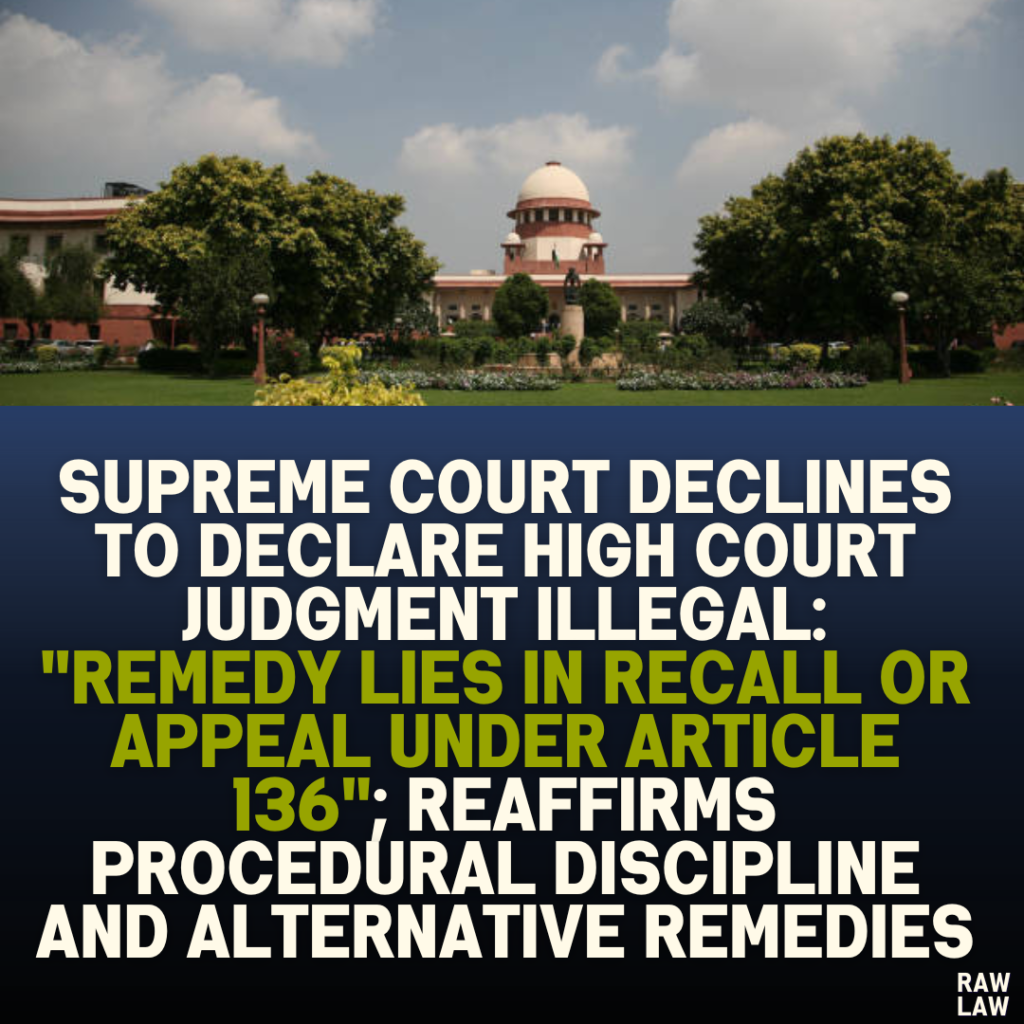Court’s Decision
The Supreme Court dismissed the writ petition filed under Article 32 of the Constitution. The petition sought to declare a Bombay High Court judgment as illegal. The Supreme Court held that:
- The petitioners could not use Article 32 to challenge a High Court judgment.
- Instead, they were directed to pursue remedies like:
- Filing an application for recall of the judgment before the High Court.
- Filing an appeal under Article 136 of the Constitution before the Supreme Court.
The Court stated that Article 32 was not meant to bypass the established procedural remedies.
Facts
The case originated from a dispute involving properties constructed by the petitioners on alleged government land. The petitioners had approached the Bombay High Court earlier, seeking reliefs regarding their property rights. The High Court dismissed their petition, and subsequent legal efforts, including a Special Leave Petition (SLP), were unsuccessful.
The petitioners then filed a writ petition under Article 32 in the Supreme Court, alleging that:
- The Bombay High Court judgment was passed without hearing all necessary parties.
- The state authorities should be directed to survey the properties to ascertain any encroachment.
- The petitioners’ apartments should be regularized, granting them occupancy or leasehold rights over government land.
- Authorities should be restrained from interfering with the enjoyment of the apartments until property disputes were resolved through due process.
Issues
- Can the Supreme Court declare a High Court judgment as illegal under Article 32?
- Should the Supreme Court grant relief for regularizing apartments allegedly constructed on government land?
- Should the state authorities be restrained from interfering with the petitioners’ property rights until due process is followed?
Petitioner’s Arguments
The petitioners argued that:
- The Bombay High Court’s judgment was illegal as it was passed without hearing necessary parties.
- Their fundamental rights were being violated due to the non-regularization of their apartments.
- The authorities were acting against them without adhering to due legal procedures, warranting the Supreme Court’s intervention.
They requested the Court to:
- Declare the High Court judgment illegal.
- Direct the authorities to survey the properties and regularize them.
- Restrain the authorities from interfering with their rights until ownership disputes were resolved.
Respondent’s Arguments
The respondents opposed the petition, asserting that:
- Article 32 could not be invoked to declare a High Court judgment illegal. The petitioners had remedies under the law, such as filing a recall application before the High Court or an appeal under Article 136 of the Constitution.
- The reliefs sought by the petitioners, including regularization of government land and restraint orders, were beyond the scope of Article 32.
- The petitioners were attempting to bypass established legal remedies, and the Supreme Court should dismiss the petition.
Analysis of the Law
- Scope of Article 32: Article 32 is reserved for enforcing fundamental rights, not for declaring High Court judgments as illegal. Challenging High Court decisions requires procedural remedies, such as filing a recall application or an appeal under Article 136.
- Encroachment and Regularization: Ownership disputes and encroachments over government land must be resolved through statutory processes. Courts cannot pass orders for regularization without due inquiry and compliance with applicable laws.
- Alternative Remedies: The legal framework provides clear options for challenging judgments:
- Recall applications before the concerned High Court.
- Appeals under Article 136 to the Supreme Court.
The Court emphasized that bypassing these remedies undermines judicial discipline and procedural integrity.
Precedent Analysis
The Supreme Court relied on established principles that:
- Article 32 is not a substitute for procedural remedies under Articles 136 or High Court recall applications.
- Petitioners must exhaust all available remedies before invoking Article 32 for relief.
The Court cited its consistent position that procedural discipline ensures fairness and adherence to legal protocols.
Court’s Reasoning
- The Supreme Court clarified that the petitioners had alternate remedies available and could not invoke Article 32 as a shortcut.
- It rejected the contention that the High Court judgment was illegal due to non-hearing of necessary parties, holding that procedural remedies like recall applications were the correct course.
- The Court highlighted that granting relief for property regularization and restraining authorities required a thorough factual inquiry, which could not be conducted under writ jurisdiction.
Conclusion
The Supreme Court dismissed the writ petition, stating that:
- The petitioners could file a recall application before the Bombay High Court or an appeal under Article 136.
- Article 32 was not the appropriate remedy in this case.
The Court left it open for the petitioners to pursue remedies as permitted under the law.
Implications
This judgment reinforces:
- The limited scope of Article 32, restricting its use to enforcing fundamental rights and not for bypassing procedural remedies.
- The importance of adhering to procedural discipline in challenging judicial decisions.
- The judiciary’s insistence on exhausting alternative remedies before seeking intervention from the Supreme Court.
The ruling serves as a precedent, discouraging the misuse of Article 32 and emphasizing the necessity of following statutory processes for property disputes and judicial challenges.
